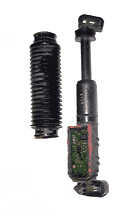| |
 |
        |
|

Air Suspension Explained

Front Strut

Rear Bag

Compressor Relay

Compressor/Dryer

Height sensor
(disassembled)
|
The Mark VIII has airbags at each corner. The
front airbag is integrated into the design of
the shock absorber and resembles a standard
McPherson strut/coil spring combination. The
rear airbag is a standalone unit separate from
the rear shock. The air bag acts as the spring
mechanism that works in conjunction with the
shock absorber to provide a nice, smooth ride.
The system uses an onboard 12v air compressor to
fill the bags when needed. Also included in the
package and attached directly to the compressor
is an air dryer. The function of the dryer is to
capture the moisture that is released when the
air is compressed and pumped into the air bags.
Downstream from the dryer and mounted on each
bag are solenoid operated valves. These valves
allow air into and out of the bag, similar to a
doorway. The valves open when voltage is applied
to the solenoid. Additionally, the compressor
has a solenoid operated valve that allows air to
escape the system entirely.
Controlling everything behind the scenes is the
suspension ECU. It's job is to monitor the
system inputs and keep everything working in
cadence. The ECU controls the air compressor
through a solid state relay. When the time comes
to raise the vehicle, the ECU grounds the
compressor relay and the compressor begins to
run. The ECU uses three height sensors to
determine vehicle height, two up front and one
out back mounted on the drivers side rear
suspension arm. The ECU sends out a 5v reference
voltage to each of the three height sensors. The
voltage that comes back from the sensors tells
the computer that:
A) The vehicle is too low
B) The vehicle is too high
C) The vehicle is at trim height
If the car is found to be too low, the computer
engages the compressor, then one second later
opens the solenoid valves, raising the car. As
the car raises the voltage signal sent back to
the computer changes. When the car reaches trim
height the compressor shuts off and the
solenoids close. In the case of scenario B, the
computer will open the vent valve and the
corresponding solenoid valve of the high corner,
therefore lowering the car. If the height
sensors check out fine, the computer does
nothing but continue to monitor it's inputs,
averaging the values and performing height
corrections every 45 seconds if needed.
 Mark VIII Air-Suspension Diagram (NOTE:
Height sensors not shown)
Mark VIII Air-Suspension Diagram (NOTE:
Height sensors not shown)
|
HEIGHT ADJUSTMENTS:
The suspension is programmed to do a number
of things automatically. The vehicle has
two different ride heights. The first is the
parked height. This is the the height the car
rests to when parked. To account for the weight
of passengers and luggage, the car has a
predetermined height that it will raise to when
making height corrections. When you get in and
drive the car, it raises 20mm above where it was
sitting when parked. If you accelerate to
105km/hr (~63mph), the vehicle drops 20mm for a
more stable high speed profile. As soon as your
speed decreases to ~45mph, the vehicle raises
20mm. When you park the car and shut the last
door, it drops 20mm down to parked height.
While driving, the computer uses a long term
strategy. The computer is constantly checking
it's height sensors and computing an average
ride height. It will adjust vehicle height only
when the average is not within predetermined
limits. As mentioned, this is only necessary
when speeds go above 63mph and when speed
decreases back down to 45mph. There should not
be any other height adjustments under normal
circumstances. Occasionally, a corner may be
high or low and the compressor will run or the
car will drop, but this is not usually the case.
If you hear the compressor running excessively,
you probably have a leak. It is important that
you fix a bad airsping quickly to avoid further
damage to the compressor.
While the car is parked, the computer uses a
different strategy, called the short term
strategy. This means the computer will adjust
immediately according to the input of its height
sensors. This is why the car will vent when
jacked up with the air suspension switch on.
What happens is the sensors sense the car is too
high so the computer tries to compensate by
venting air out of the system. Since the jack is
under the car not allowing it to drop, the
computer ends up venting for the maximum length
of time (45 seconds). This should not hurt
anything and the car should raise back up to
trim height when started. This short term
strategy has a time window of one hour. At the
end of the hour period, the computer runs a
check of it's sensors and will raise the car if
necessary at that time. |

|

 |
|
| |
All photos, unless noted, copyright Lincoln Motor
Company. Reproduction by any means other than for personal use is
strictly prohibited.
Permission to use material on this site can be obtained
by contacting the webmasters.
Website Designed by Vistitude Computer Solutions, Inc
|
|

![]()















 Mark VIII Air-Suspension Diagram (NOTE:
Height sensors not shown)
Mark VIII Air-Suspension Diagram (NOTE:
Height sensors not shown)